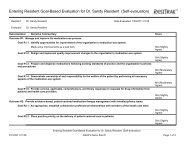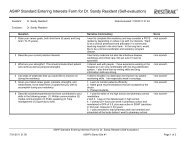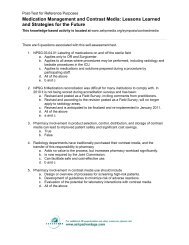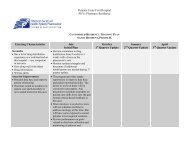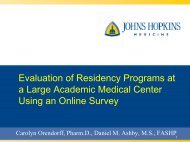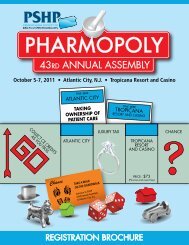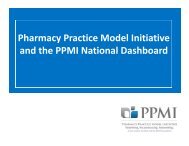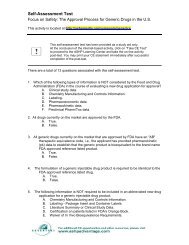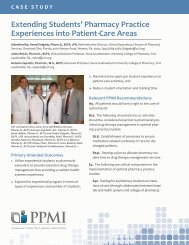Self-Assessment Test Improving IV Medication Safety Identifying the Risk Points
Self-Assessment Test - Ashpmedia.org
Self-Assessment Test - Ashpmedia.org
- No tags were found...
You also want an ePaper? Increase the reach of your titles
YUMPU automatically turns print PDFs into web optimized ePapers that Google loves.
<strong>Self</strong>-<strong>Assessment</strong> <strong>Test</strong><strong>Improving</strong> <strong>IV</strong> <strong>Medication</strong> <strong>Safety</strong>: <strong>Identifying</strong> <strong>the</strong> <strong>Risk</strong> <strong>Points</strong>This program is located at http://ashpmedia.org/symposia/<strong>IV</strong>safetyThis self-assessment test has been provided as a study aid only.At <strong>the</strong> conclusion of <strong>the</strong> internet-based activity, click on “Take CE <strong>Test</strong>”to proceed to <strong>the</strong> ASHP Learning Center and take <strong>the</strong> on-line activitypost-test. You may print your CE statement immediately after successfulcompletion of <strong>the</strong> post-test.There are a total of 13 questions associated with this self-assessment test.1. Harmful wrong route errors include all EXCEPT:a. Oral liquid given intravenously (i.v.)b. i.v. given intra<strong>the</strong>cally.c. Tube feedings given po.d. Tube feedings given i.v.2. <strong>Risk</strong>s associated with i.v. medications include all EXCEPT <strong>the</strong> following:a. Complexity of pharmaceutical calculations.b. Computerized prescriber order entry.c. Lack of knowledge and training in i.v. medication <strong>the</strong>rapy.d. Wrong route of administration.3. <strong>IV</strong> <strong>Safety</strong> Solutions include all of <strong>the</strong> following EXCEPT:a. Labeling of i.v. lines.b. Storing oral syringes on pediatric units.c. TPN compounders.d. Standardizing dose units4. Which intravenous medication is most often associated with harm?a. Morphine.b. Vincristine.c. Diazepam.d. Natalizumab.5. Which of <strong>the</strong> following factors was independently associated with reduced risk ofparenteral medication administration errors according to <strong>the</strong> multinational studyconducted by <strong>the</strong> European Society of Intensive Care Medicine (ESICM) and <strong>the</strong>Sentinel Events Evaluation (SEE) study reported in 2009?a. Routine i.v. checks at change of shift.b. Low rates of patient turnover.c. Larger intensive care units.d. Drugs centrally prepared by pharmacist (vs. nurse).e. Fewer different types of infusion devices.
<strong>Self</strong>-<strong>Assessment</strong> <strong>Test</strong><strong>Improving</strong> <strong>IV</strong> <strong>Medication</strong> <strong>Safety</strong>: <strong>Identifying</strong> <strong>the</strong> <strong>Risk</strong> <strong>Points</strong>This program is located at http://ashpmedia.org/symposia/<strong>IV</strong>safety6. Multiple overrides of safety features in medication safety technology by nurses is anindication fora. Structured consequences for violations.b. Mandated annual training.c. Study of failure modes and work flow.7. Which of <strong>the</strong> following concerns about ADC (automated dispensing cabinet)technology was NOT articulated by nurses according to <strong>the</strong> ISMP blog?a. Interruptions when selecting medications from ADC.b. Frequent overrides.c. Access of students to ADC.d. Removal of multiple patients’ drugs at <strong>the</strong> same time.8. The major safety issue in bolus injection isa. Failure to label syringes.b. i.v. infiltration.c. Excessive speed of injection.d. Break in aseptic technique.9. A CalNOC (Collaborative Alliance for Nursing Outcomes) best practice in medicationadministration isa. The seven rights of medication administration.b. Take <strong>the</strong> MAR to <strong>the</strong> bedside.c. Reconcile medication list at each transfer.d. Compare <strong>the</strong> drug to <strong>the</strong> MAR.10. Which substantial cause of medication administration error has been mostsuccessfully addressed by CPOE (computerized prescriber order entry)?a. Lack of decision support for nurses.b. Illegible handwriting.c. Communication among providers.d. Complexity of medication orders.11. The Japanese study of factors associated with near misses reported by Seki andassociates in 2006 suggests which statement is <strong>the</strong> best indicator a nurse is athigh risk of intravenous medication error?a. I am so busy that I’m late with most treatments.b. I have a larger patient assignment than usual.c. I felt really tired at <strong>the</strong> start of <strong>the</strong> shift.d. I have worked on this ward for years.
<strong>Self</strong>-<strong>Assessment</strong> <strong>Test</strong><strong>Improving</strong> <strong>IV</strong> <strong>Medication</strong> <strong>Safety</strong>: <strong>Identifying</strong> <strong>the</strong> <strong>Risk</strong> <strong>Points</strong>This program is located at http://ashpmedia.org/symposia/<strong>IV</strong>safety12. Of <strong>the</strong> following, which can be classified as an i.v. room preparation error?a. A nurse administers an i.v. medication at <strong>the</strong> incorrect time as ordered.b. A technician prepares an i.v. medication in an incorrect base solution.c. A pharmacist misinterprets a prescriber’s order for an i.v. medication.d. None of <strong>the</strong> above.13. Barcode technology can be used to enhance <strong>the</strong> safe delivery of compoundedsterile products (CSP) by providing a high reliability verification and feedback inreal time that <strong>the</strong> correct product is used to manufacture <strong>the</strong> CSP.a. True.b. False.



